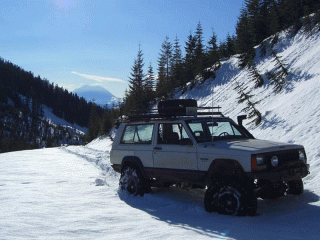Driving for hours up a mountain in the snow, with the express purpose of sleeping outdoors in freezing temperatures, sounds like lunacy to most people. Nearly everybody I mentioned it to, in fact. Looking for someone to go with, I floated the idea to a couple of local Jeep clubs that I belong to. After all, misery loves company but in the end there were only two people crazy enough to do it with me.
[Not a valid template]Ian and I had never done any true “snow camping” before so we were very grateful to have Michael along with us. He’s so hardcore that he even manufactured his own snow saw. Really.
Our route this trip would be up Tinkham Road, off Interstate 90 about 45 minutes East of Seattle, Washington, just west of Snoqualmie Pass. “The Pass” as the locals call it, crosses the Cascade Mountain range, effectively the dividing line between Western and Eastern Washington. Snoqualmie Pass is also home to several popular local ski areas.
The three of us met at 9:00am on a blissfully clear and crisp February morning and aired down to about 10 psi, just off the freeway. We shared an icy frontage road with cross-country skiers for a while, before making our way up the mountain. Dodging them was an additional challenge.
At one point I came upon a group of three skiers without them hearing me until I was pretty close. I double-clutched into first, blipping the throttle to match the revs. The sudden and loud noise of a barely muffled 4-liter 6 turning 3500 rpm sent them jumping into the ditch. Of course, I was only doing 2 mph and was still a ways away from them, but it gave them quite a start. Luckily they were cool about it, all grinning sheepishly as they brushed themselves off and we went on past them.
The road leading up the mountain goes under the historic Chicago, Milwaukee, St. Paul and Pacific Railroad’s Chicago to Seattle line, built in the late 1800’s. It was abandoned in 1980 and turned into biking and hiking trails, now called the Iron Horse State Park and John Wayne Pioneer Trail. Just further east it snakes its way under the mountains into a 2.3 mile long tunnel, one of the longest in the U.S. when it was built between 1908 and 1914.
